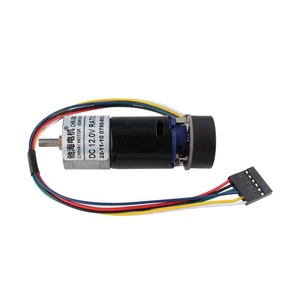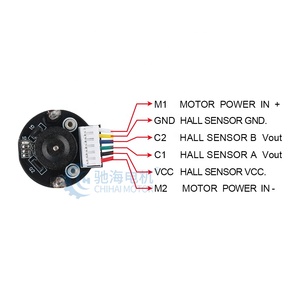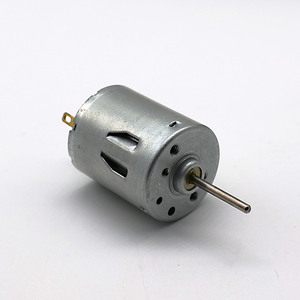
All categories
Featured selections
Trade Assurance
Buyer Central
Help Center
Get the app
Become a supplier

(2472 products available)

















































Brushed Mini DC Motors with Encoders
The brushed mini DC engines with encoders are famous for their ease of operation and low cost. They comprise a set of brushes and a commutator, which helps direct the current to different motor segments. This kind of motor is also an encoder mounted on the axle or within close vicinity to monitor the axial movement of the shaft. The encoder's feedback allows for precise movement control, common in lower power applications. Despite brushed motors requiring more maintenance due to brush wear, their simplicity and cost-effectiveness make them an acceptable choice for various uses.
Brushless Mini DC Motors with Encoders
Unlike handy mini DC motors, brushless motors do not have brushes. Therefore, such motors do not have any obstruction while operating, meaning they need zero-maintenance motors. This type of motor is known for its higher performance, reliability, and efficiency encoders, often mounted close to the shaft, provide exceptional feedback and ensure the accurate position of control. Brushless motors are commonly used in applications that require high performance, longevity, low noise, and heat, such as medical devices, aerospace applications, and electric potencies.
Servo Mini DC Motors with Encoders
Servo motors are a class of mini DC motors that integrate an encoder to provide advanced control capabilities. These motors perform some motion control due to their ability to control position, velocity, and torque regarding setpoints. A closed-loop system typically consists of a servo motor, feedback from the encoder, and a controller, forming a control system that can precisely monitor and regulate motor performance. The high level of precision makes these motors ideal for robotics, CNC machines, and aerospace functions, where exact movements are essential.
Planetary Gear Mini DC Motors with Encoders
For applications that require high torque and low speed, a planetary gear system is fitted to the motor shaft, and an encoder is fitted on the output shaft of a planetary gear. Practically all these motors are closed, and they have a feedback control system that enables high accuracy during operation. These motors are commonly used in applications needing high mechanical advantages and precise motion control, such as robotics, automation, and medical equipment.
Robotics
Mini DC motors with encoders are important components in the robotics field. These motors provide control of position, velocity, and torque in robotic arms, mobile robots, and manipulators. The encoders give the robots' feedback to control accuracy, thus enabling smooth operation and reducing overshooting. Additionally, vision and precision soldering, warehouse automation, and education robots use these motors to enhance robotic mobility and improve task performance.
Automation and Control Systems
Mini DC motors with encoders are commonly used in industrial automation systems to control valves, dampers, and other mechanical devices. In such systems, encoders allow precise positioning and speed regulation, improving overall system reliability and efficiency. Common applications include manufacturing plants, HVAC systems, and chemical processing facilities, where accurate control of equipment is vital for optimal operations.
Medical Equipment
Instruments such as pumps, ventilators, and surgical tools use a mini DC motor with an encoder in the medical area. The encoders ensure precise control of movement, which is of utmost importance when dealing with human lives and health. Medical imaging systems also use these motors to improve the positioning of scanning devices. The high level of reliability and accuracy makes them prime candidates for critical medical application use.
Aerospace and Aviation
In the aerospace sector, mini DC motors with encoders are applied to control flight surfaces and actuation systems. These motors give about speed control and a position that is vital for the navigation and stability of an aircraft. DC motors with encoders are important components in different avionics systems and satellites, mainly due to their ability to provide reliable and accurate performance in conditions of extreme temperatures.
CNC Machines
CNC (Computer Numerical Control) machines rely deeply on mini DC motors with encoders for precise cutting, milling, and drilling operations. The encoders give feedback to ensure that the motors turn to the correct position and speed, thus producing high accuracy during machining operations. The application is used widely in the manufacturing sector, as the requirement for precision in the production of mechanical components is of paramount importance.
Voltage Rating
Mini DC motors can be in different voltage ranges, whereby the most commonly used are 3-12V and 24V. Higher voltage ratings mean larger power output and, thus, performance. The voltage rating for a given application needs to be considered.
Speed and RPM
Speed is a function of the voltage applied to a motor. Most mini DC motors usually have a speed of between 100 and 10,000 revolutions per minute (RPM). The motor's speed is defined based on the application for which it will be used since; for most cases, low-speed motors are preferred, such as in medical and aerospace engines, while in the CNC, one needs high-speed motors with encoders.
Torque
Torque is an important parameter in mini DC motors, as it determines the amount of load that can be driven. The encoders provide feedback that helps the torques output of the motor, which avoids overload situations. Most mini DC motors produce up to 0.5Nm torque, while some have produced as much as 5Nm.
Encoder Resolution
How much the encoder is offset or the smallest movement that is offset is referred to as encoder resolution. This is typically measured in pulses per revolution (PPR). The highresolution encoders provide very accurate control, mainly in applications such as CNC machines, PPR values are from 10 to 1000.
Brushless Design
Mini DC motors with encoders are mainly brushless design, thus reducing the wear and tear largely observed in brushed motors. Brushless motors also eliminate the major causes of heat generation and reduction of motor life. Moreover, the absence of brushes translates to greater reliability in areas that require seismic action.
High-Quality Materials
Manufacturers of mini DC motors use materials such as carbon steel alloys for shafts and stainless steel for encoders. Stainless steel is highly corrosion resistant, while shaft materials provide great tensile strength. Mini DC motors can be maintained for a longer time because of this.
IP Rating
Mini DC motors encoders have an Ingress Protection rating that shows the environmental conditions that withst and the motor can withstand. Most mini DC motors have an IP65 rating, meaning they are protected against water and dust. This makes it suitable for usage in nonideal conditions.
Mounting the Motor
The first installation process involves fixing the motor in the location of the designated use. The mounting can be through a bracket, coupling, or direct integration, depending on the application. Care should be taken to align the motor properly with the attached mechanical systems to reduce vibration and ensure efficient energy transmission.
Connecting the Encoder
Encoders require a connection to a control system or data processing system. This involves wiring, the power supply, and the signal lines to the controller or interface circuit. Care must be taken to avoid damage by following the manufacturer's guidelines regarding wiring and connection.
Power and Control System Integration
Subsequently, the motor and encoder should be connected to the power and control system. A motor driver or controller that converts the signal into corresponding commands needs to be integrated. DC motors are coupled with encoders to control systems in industrial areas, such as PLCs, where they interface with other systems using power supply, signal, and feedback check interconnections.
Testing
Installation is complete after the testing checks if the system is functioning correctly. Once power is supplied and the controller is active, one has to check encoder signals, motor movement, and proper feedback. There should also be close monitoring of parameters such as speed, position, and torque so that the adjustments can be made where necessary.
Application Requirements
Before purchasing, one has to be clear about the needs of the application. In general, factors such as speed, torque, and accuracy need to be considered carefully. It is also important to know the working environment so that a motor can be chosen to suit the working conditions.
Encoder Type
Mini DC motors with encoders have different types of encoders: incremental and absolute. Most applications require incremental encoders that give position feedback during a task. Such types of encoders are used in mostly fast applications. Other applications use absolute encoders that record the position of the shaft, such as robotics.
Torque and Power
One should also ensure that the motor has adequate power output and torque to perform the required task. If an automatic system uses a gear reduction system, one would need a motor with a smaller torque. Speed and RPM are other important factors that need to be considered regarding power, which is the electrical motor's voltage rating.
Size and Form Factor
One should look at the physical dimensions and chassis. Be sure that space at the installation area will allow the proper motor to be installed. It is also necessary that the motor is not proportionally designed with other surrounding components.
Control Compatibility
The control system needs to be compatible with the mini DC motor encoders to facilitate proper operation. Be aware of the controller type, whether it's an industrial PLC, a microcontroller, or something else. Ensure that the interface of the encoder is supported by the control system.
Budget and Cost
The cost of a mini DC motor encoder can be quite extensive, depending on the features, specifications, and quality. Ensure to set a budget but then weigh the cost against the potential needs of the application. That performance and reliability will surely pay off in the long run, as one might need to get a quality motor for critical tasks.
A1: These motors provide nice feedback control accuracy so that smooth torque and speed transitions would be easy. They are essential for improving mobility and task performance with precision in robotic applications.
A2: Inte gral encoders fitted to mini DC motors provide position feedback. This feedback allows control systems to adjust motor output in real time for precise speed and position control in various applications.
A3: Brushless motors usually have better efficiency and reliability, while the leads are less expensive and easier to install. Depending on the application, one must weigh these factors, such as cost-effectiveness.
A4: Medical-grade mini DC motors should be produced to last longer with quality materials, IP ratings, and brushless design to ensure reliability in sensitive applications.
A5: Mainly, maintenance is less common in brushless DC motors, while brushed motors need some routine checks. Regardless, a client should consult manufacturer's instructions for proper maintenance guidelines.